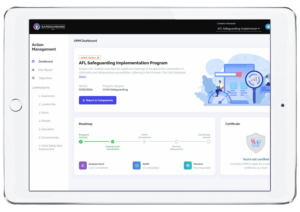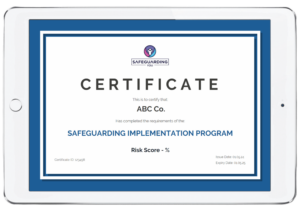Safeguarding Basketball:
A Holistic Approach to Wellbeing
Because safeguarding kids doesn't just happen.
Basketball is more than just a game—it’s a community, a passion, and a platform for growth. At Safeguarding You, we’re here to ensure that every player, coach, official, and supporter can thrive in a safe, inclusive, and supportive environment.
Our comprehensive programs for basketball integrate Child Safety and Concussion Management into one streamlined solution. Built on the principles outlined in Basketball Australia’s Child Safeguarding Guidelines and other relevant standards, our approach is designed to help basketball clubs and leagues meet their obligations while fostering a culture of care.
Changing the Game of Safeguarding
Complete
Safeguarding
Online programs in a central, easy-to-use platform for clubs to manage compliance, risks, and wellbeing.
Tailored for
Basketball Clubs
Designed with the unique challenges of basketball in mind, our programs align with BA standards and guidelines.
Empowering
Clubs to Thrive
More than just tools - we allow clubs to focus on what they do best... fostering a love of the game.
Online + Realtime Programs
Protecting Young Players on and off the Court.
Basketball clubs often serve as a starting point for young athletes, but inadequate safeguarding measures can leave children vulnerable to risks, from inappropriate conduct to unsafe environments. Without clear policies, training, and processes, clubs may struggle to meet their responsibilities and maintain parents’ trust.
Failing to safeguard children can lead to devastating outcomes – both for the young athletes involved and the organisations responsible. Allegations of misconduct can damage reputations, erode community trust, and expose clubs to legal and financial consequences.
Our child safety program equips basketball organisations with the tools to align with Basketball Australia’s safeguarding guidelines. We provide resources to develop clear policies, implement training for staff and volunteers, and establish robust incident reporting and management processes. By fostering a culture of safety and transparency, your club can protect its players and strengthen community confidence.
Prioritising Player Health
While basketball isn’t typically seen as a high-contact sport, concussions remain a significant risk, particularly from accidental collisions, falls, and impacts during play. Many clubs lack the knowledge or resources to handle concussions effectively, putting players at risk of long-term health complications.
Improper management of concussion incidents can have serious consequences, from prolonged recovery periods to permanent brain injuries. Without appropriate protocols, clubs expose themselves to liability and risk losing trust from players and their families.
Our concussion management program ensures basketball organisations can effectively prevent, manage, and monitor concussion incidents. We provide education for coaches and trainers, implement best-practice game-day protocols, and develop return-to-play guidelines aligned with the Australian Institute of Sports concussion standards. With Safeguarding You, your club can prioritise player health while reducing risks and maintaining compliance.
How It Works





Programs Include
-
Smart Self Assessment
-
Risk Report: High-Med-Low
-
Action Management Module
-
Incident Management
-
Digital Library of Resources
-
24/7 Realtime Access
Program Modules
Child Safety
Placing the highest priority on the safety and well-being of all participants. We are committed to creating a secure environment by implementing comprehensive safety protocols, ensuring all activities are conducted with the utmost regard for the physical and emotional safety of our players.
Celebrating diversity and strive to create an inclusive environment where everyone, regardless of their background, feels valued and respected. Ensures equal opportunities for all participants, actively promoting practices that embrace cultural, gender, and ability diversity.
Staff and volunteers are the backbone of an organisation, and ensure they are well-equipped to support their safeguarding goals. All staff and volunteers undergo rigorous background checks and training to uphold the highest standards of child safety and welfare.
Dedicated to recruiting individuals who share your commitment to child safety. Your recruitment process includes thorough vetting, interviews, and reference checks to ensure that only the most suitable candidates join your team, thereby safeguarding the integrity of your organisation.
New recruits participate in a comprehensive induction and ongoing training program designed to educate them on safeguarding policies, procedures, and best practices. Continuous professional development ensures that staff and volunteers are always up-to-date with the latest safeguarding standards.
Engaging with your community is essential for the success of your safeguarding efforts. Fostering strong partnerships with local organisations, schools, and families to promote a culture of safety and well-being, ensuring a collective approach to safeguarding in basketball.
Establish clear and accessible reporting mechanisms for all concerns related to child safety. Reporting processes ensure confidentiality and immediate action, empowering participants to speak up and ensuring that all incidents are handled promptly and effectively.
Safeguarding policies and practices are comprehensive and regularly reviewed to reflect best practices and legal requirements. Policies should cover all aspects of your program and be designed to protect participants, staff, and volunteers, ensuring a safe and supportive environment.
Zero tolerance for sexual misconduct and implement strict measures to prevent, detect, and respond to any instances of such behavior. Policies should include clear guidelines, mandatory training, and a robust reporting and response system to ensure the safety and dignity of all participants.
Maintaining professional boundaries is crucial for safeguarding. Guidelines help staff and volunteers understand the importance of appropriate interactions, ensuring relationships with participants are respectful, supportive, and free from any form of exploitation or misconduct.
Emphasise the importance of using positive, respectful, and age-appropriate language. Staff and volunteers should be trained to communicate in a manner that fosters self-esteem and respect, avoiding any language that could be harmful or degrading to participants.
Your approach to discipline should be based on positive guidance, focusing on encouragement and constructive feedback. Promoting fair and consistent discipline practices that respect the dignity of each participant, fostering a positive and supportive environment.
Effective supervision is key to ensuring the safety of participants. Including strict supervision ratios, regular headcounts, and clear procedures for monitoring participants during activities, minimising risks and ensuring a safe environment.
With the increasing use of digital platforms, establish clear guidelines for online communications. These guidelines ensure that all interactions are safe, professional, and transparent, protecting participants from any form of online abuse or exploitation.
Strict protocols for photography and video recording to protect the privacy and dignity of participants. Consent should be obtained before sharing and publishing images, and all media is used in accordance with safeguarding policies, ensuring appropriate and respectful representation.
Appropriate physical contact is sometimes necessary in sports. Guidelines ensure that all physical interactions are safe, respectful, and appropriate to the context, with the comfort and consent of the participant always prioritised.
When overnight stays are required, implement stringent safety measures. This includes thorough planning, clear supervision arrangements, and ensuring that accommodation meets safety standards, providing a secure environment for all participants.
Maintain strict protocols for change room arrangements to ensure privacy and safety. These include supervised access, designated areas for different age groups, and clear rules about conduct in these spaces, minimising risks and ensuring participant comfort.
Strictly prohibit the use of alcohol and drugs in junior basketball. Promote a healthy and safe environment by educating participants about the risks associated with substance abuse and enforcing a zero-tolerance policy to ensure a safe and supportive atmosphere.
Engaging parents and guardians is vital for effective safeguarding. Encourage their active involvement, providing them with the necessary information and support to understand and contribute to your safeguarding efforts.
Safe transportation practices are a priority. Guidelines ensure that all transportation arrangements are planned, supervised, and conducted by vetted individuals, with clear protocols to ensure the safety and well-being of participants during transit.
Establish clear procedures for the drop-off and pick-up of children to ensure their safety. These include designated areas, supervised handover processes, and clear communication with parents and guardians to prevent any unauthorised access or incidents.
Concussion
Club governance frameworks ensure that you prioritise player safety by implementing and enforcing rigorous concussion management policies. This includes the appointment of a dedicated Concussion Officer, regular training for all stakeholders, and the maintenance of detailed records to track compliance and ensure best practices are followed consistently.
On the day of injury, appropriate protocols ensure immediate and effective management of suspected concussions. This involves removing the player from play, conducting an initial assessment using standardised tools, and providing a quiet, safe environment for further evaluation, ensuring no player returns to the game until medically cleared.
Return to play protocols are designed to prioritise the health and recovery of players. These protocols require a step-by-step, individualised approach, ensuring players are symptom-free and have received medical clearance before resuming full contact activities, thus preventing premature returns and minimising the risk of further injury.
For players experiencing prolonged symptoms or multiple concussions, a robust management system in essential. This includes comprehensive medical evaluations, tailored recovery plans, and ongoing monitoring by healthcare professionals to ensure safe and effective recovery before returning to play.
Reduce the risk of concussion and head impacts by emphasising proper training techniques, enforcing the use of protective equipment, and staying up-to-date with rule changes that promote safer play. A proactive approach aims to minimise the frequency and severity of head injuries in players.
Utilise comprehensive diagnosis techniques to accurately assess and manage concussions. This includes the use of tools like the SCAT6, regular medical evaluations, and incorporating input from parents and teachers to ensure a holistic understanding of the player’s condition.
Recognising the unique needs of children and adolescents includes age-appropriate concussion management strategies. Ensure that young athletes are fully recovered and have returned to normal school activities before resuming sports, with continuous monitoring and communication between parents, teachers, and healthcare professionals.
Clear roles and responsibilities are defined to ensure effective implementation. From the Concussion Officer to coaches, medical staff, parents, and players, everyone has a specific role in recognising, managing, and preventing concussions, fostering a collaborative and supportive environment for player safety.
Optional Extras... Review & Certify
This Means: Order a Program Review & Receive a Certificate of Assessment


Safeguarding Survival Guide
Tailored for CSO’s, this guide cuts through the noise to deliver actionable strategies in Child Safeguarding.
More than just advice – it’s a blueprint for success. Avoid pitfalls, make smart decisions, and drive your organisation towards safer standards and sustainable growth. Don’t miss out on this opportunity to turn information into power.
The Child Safeguarding Survival Guide




